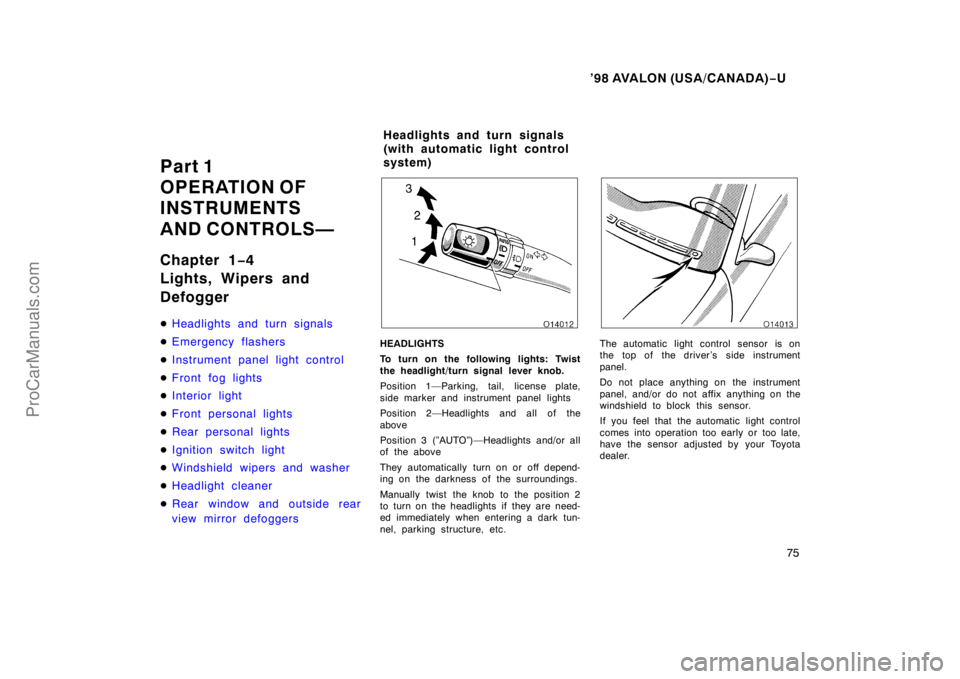Page 52 of 233

’98 AVALON (USA/CANADA)−U
52
In a severe side impact, the side airbag
sensor triggers the side airbag inflators.
Then a chemical reaction in the inflators
momentarily fills the air bags with non−tox-
ic gas to help restrain the forward or lat-
eral motion of the occupants.
When the airbags inflate, they produce a
fairly loud noise and release some smoke
along with non −toxic gas. This does not
indicate a fire. Be sure to wash off any
residue as soon as possible to prevent
minor skin irritation.
Deployment of the airbags happen in a
fraction of a second, so the airbags must
inflate with considerable force. While the
system is desi gned to reduce serious inju-
ries, it may also cause minor burns or
abrasions and swellings.
Front seats may be hot for several min-
utes, but the airbags themselves will not
be hot. The airbags are designed to inflate
only once.CAUTION
�The SRS side airbag system is de-
signed only as a supplement to the
primary protection of the driver
side and front passenger side seat
belt systems. The front seat occu-
pants can be killed or seriously in-
jured by an inflating airbag if they
do not wear the available seat
belts. During sudden braking just
before a collision, an unrestrained
driver or front passenger can move
sideward into direct contact with or
close proximity to the airbag which
may then deploy during the colli-
sion. To obtain maximum protection
in an accident, the driver and all
passengers in the vehicle must
wear their seat belts. Wearing a
seat belt during an accident re-
duces the chances of death or seri-
ous injuries or being thrown out of
the vehicle. For instructions and
precautions concerning the seat
belt system, see ”Seat belts” in this
chapter.
�Improperly seated and/or restrained
infants and children can be killed
or seriously injured by a deploying
airbag. An infant or child who is
too small to use a seat belt should
be properly secured using a child
restraint system. Toyota strongly
recommends that all infants and
children be placed in the rear seat
of the vehicle and properly re-
strained. The rear seat is the safest
for infants and children. For in-
structions concerning the installa-
tion of a child restraint system, see
”Child restraint” in this chapter.
�Do not allow the child to lean
against the front door or around
the front door even if the child is
seated in the child restraint system.
It is dangerous if the side airbag
inflates and the impact could cause
death or serious injury to the child.
For instructors concerning the
installation of a child restraint sys-
tem, see ”Child restraint” in this
chapter.
ProCarManuals.com
Page 75 of 233

’98 AVALON (USA/CANADA)−U
75
Part 1
OPERATION OF
INSTRUMENTS
AND CONTROLS—
Chapter 1 −4
Lights, Wipers and
Defogger
� Headlights and turn signals
� Emergency flashers
� Instrument panel light control
� Front fog lights
� Interior light
� Front personal lights
� Rear personal lights
� Ignition switch light
� Windshield wipers and washer
� Headlight cleaner
� Rear window and outside rear
view mirror defoggers
HEADLIGHTS
To turn on the following lights: Twist
the headlight/turn signal lever knob.
Position 1—Parking, tail, license plate,
side marker and instrument panel lights
Position 2—Headlights and all of the
above
Position 3 (”AUTO”)—Headlights and/or all
of the above
They automatically turn on or off depend-
ing on the darkness of the surroundings.
Manually twist the knob to the position 2
to turn on the headlights if they are need-
ed immediately when entering a dark tun-
nel, parking structure, etc.The automatic light control sensor is on
the top of the driver’s side instrument
panel.
Do not place anything on the instrument
panel, and/or do not affix anything on the
windshield to block this sensor.
If you feel that the automatic light control
comes into operation too early or too late,
have the sensor adjusted by your Toyota
dealer.
Headlights and turn signals
(with automatic light control
system)
ProCarManuals.com
Page 91 of 233

’98 AVALON (USA/CANADA)−U
91
(i) Rear Light Failure Warning Light
If this light comes on when the headlight
switch is turned on (at the position 1 or
position 2), it indicates that one or more
of the tail lights are burned out.
If it comes on when the brake pedal is
depressed, one or more stop lights are
burned out.
Have defective bulbs replaced as soon as
possible.
(j) SRS Airbag Warning Light
This light will come on when the igni-
tion key is turned to the ”ACC” or
”ON” position. After about 6 seconds,
the light will go off. This means the
system of the airbag and front seat belt
pretensioners are operating properly.
The warning light system monitors the air-
bag sensor assembly, seat belt pretension-
er assembly, inflators, warning light, inter-
connecting wiring, power sources.
If either of the following conditions occurs,
this indicates a malfunction somewhere in
the parts monitored by the warning light
system. Contact your Toyota dealer as
soon as possible to service the vehicle.�The light does not come on when the
ignition key is turned to the ”ACC” or
”ON” position or remains on.
�The light comes on or flashes while
driving.
(k) ”TRAC OFF” Indicator/Warning light
This light comes on when the ignition key
is turned to ”ON”, and will go off after 3
seconds. This means that the system is
operating properly.
If one of the following conditions occurs,
this indicates a malfunction somewhere in
the parts monitored by the warning light
system. Contact your Toyota dealer as
soon as possible to service the vehicle.
�The light remains on more than 3 se-
conds after the ignition switch is turned
on.
�The light comes on while driving even
if the ”TRAC OFF” switch is not
pushed.
�The light flashes. (l) Low Windshield Washer and Head-
light Cleaner Fluid Level Warning
Light (on some models)
The light warns that the windshield washer
and headlight cleaner fluid level is too
low. Add washer fluid at your earliest op-
portunity. (For instructions, see ”Adding
washer fluid” in Chapter 7 −3.)
(m) Key Reminder Buzzer
This buzzer reminds you to remove the key
when you open the driver’s door with the
ignition key in the ”ACC” or ”LOCK” position.
ProCarManuals.com